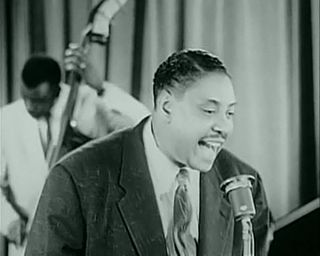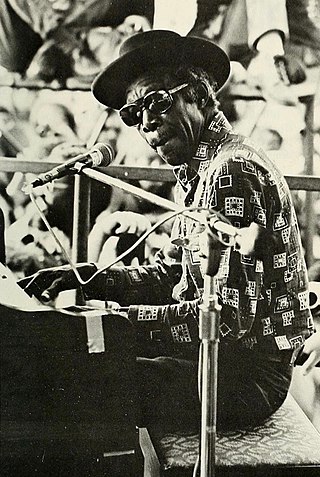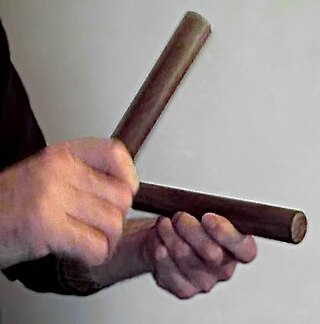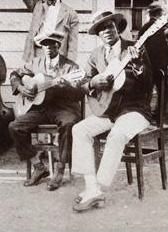
Funk is a music genre that originated in African-American communities in the mid-1960s when musicians created a rhythmic, danceable new form of music through a mixture of various music genres that were popular among African-Americans in the mid-20th century. It deemphasizes melody and chord progressions and focuses on a strong rhythmic groove of a bassline played by an electric bassist and a drum part played by a percussionist, often at slower tempos than other popular music. Funk typically consists of a complex percussive groove with rhythm instruments playing interlocking grooves that create a "hypnotic" and "danceable" feel. It uses the same richly colored extended chords found in bebop jazz, such as minor chords with added sevenths and elevenths, and dominant seventh chords with altered ninths and thirteenths.
Jazz is a music genre that originated in the African-American communities of New Orleans, Louisiana, in the late 19th and early 20th centuries, with its roots in blues and ragtime. Since the 1920s Jazz Age, it has been recognized as a major form of musical expression in traditional and popular music. Jazz is characterized by swing and blue notes, complex chords, call and response vocals, polyrhythms and improvisation. Jazz has roots in European harmony and African rhythmic rituals.

Rhythm and blues, frequently abbreviated as R&B or R'n'B, is a genre of popular music that originated within African-American communities in the 1940s. The term was originally used by record companies to describe recordings marketed predominantly to African Americans, at a time when "rocking, jazz based music ... [with a] heavy, insistent beat" was becoming more popular. In the commercial rhythm and blues music typical of the 1950s through the 1970s, the bands usually consisted of a piano, one or two guitars, bass, drums, one or more saxophones, and sometimes background vocalists. R&B lyrical themes often encapsulate the African-American history and experience of pain and the quest for freedom and joy, as well as triumphs and failures in terms of societal racism, oppression, relationships, economics, and aspirations.

Charles Joseph "Buddy" Bolden was an American cornetist who was regarded by contemporaries as a key figure in the development of a New Orleans style of ragtime music, or "jass", which later came to be known as jazz.

Henry Roeland "Roy" Byrd, better known as Professor Longhair or "Fess" for short, was an American singer and pianist who performed New Orleans blues. He was active in two distinct periods, first in the heyday of early rhythm and blues and later in the resurgence of interest in traditional jazz after the founding of the New Orleans Jazz and Heritage Festival in 1970. His piano style has been described as "instantly recognizable, combining rumba, mambo, and calypso".
The music of Louisiana can be divided into three general regions: rural south Louisiana, home to Creole Zydeco and Old French, New Orleans, and north Louisiana. The region in and around Greater New Orleans has a unique musical heritage tied to Dixieland jazz, blues, and Afro-Caribbean rhythms. The music of the northern portion of the state starting at Baton Rouge and reaching Shreveport has similarities to that of the rest of the US South.

The clave is a rhythmic pattern used as a tool for temporal organization in Brazilian and Cuban music. In Spanish, clave literally means key, clef, code, or keystone. It is present in a variety of genres such as Abakuá music, rumba, conga, son, mambo, salsa, songo, timba and Afro-Cuban jazz. The five-stroke clave pattern represents the structural core of many Cuban rhythms. The study of rhythmic methodology, especially in the context of Afro-Cuban music, and how it influences the mood of a piece is known as clave theory.
Latin jazz is a genre of jazz with Latin American rhythms. The two main categories are Afro-Cuban jazz, rhythmically based on Cuban popular dance music, with a rhythm section employing ostinato patterns or a clave, and Afro-Brazilian jazz, which includes samba and bossa nova.

Crowbar is an American sludge metal band formed in New Orleans, Louisiana, in 1990. The band is fronted by vocalist/guitarist Kirk Windstein, Crowbar's sole constant member. Through infusing a slow, low-keyed, brooding doom metal sound with the aggression of hardcore punk, they pioneered a style known as sludge metal – albeit Windstein admitted a mild dislike to the term – alongside other bands of the New Orleans heavy metal scene such as Eyehategod, Soilent Green, Acid Bath, and Down.
Afro-Cuban jazz is the earliest form of Latin jazz. It mixes Afro-Cuban clave-based rhythms with jazz harmonies and techniques of improvisation. Afro-Cuban music has deep roots in African ritual and rhythm. The genre emerged in the early 1940s with the Cuban musicians Mario Bauzá and Frank Grillo "Machito" in the band Machito and his Afro-Cubans in New York City. In 1947, the collaborations of bebop trumpeter Dizzy Gillespie and percussionist Chano Pozo brought Afro-Cuban rhythms and instruments, such as the tumbadora and the bongo, into the East Coast jazz scene. Early combinations of jazz with Cuban music, such as "Manteca" and "Mangó Mangüé", were commonly referred to as "Cubop" for Cuban bebop.
Contradanza is the Spanish and Spanish-American version of the contradanse, which was an internationally popular style of music and dance in the 18th century, derived from the English country dance and adopted at the court of France. Contradanza was brought to America and there took on folkloric forms that still exist in Bolivia, Mexico, Venezuela, Colombia, Peru, Panama and Ecuador.
Ethno jazz, also known as world jazz, is a subgenre of jazz and world music, developed internationally in the 1950s and '60s and broadly characterized by a combination of traditional jazz and non-Western musical elements. Though occasionally equaled to or considered the successor of world music, an independent meaning of ethno jazz emerged around 1990 through the commercial success of ethnic music via globalization, which especially observed a Western focus on Asian musical interpretations. The origin of ethno jazz has widely been credited to saxophonist John Coltrane.

The Spanish tinge is an Afro-Latin rhythmic touch that spices up the more conventional 4
4 rhythms commonly used in jazz and pop music. The phrase is a quotation from Jelly Roll Morton. In his Library of Congress recordings, after referencing the influence of his own French Creole culture in his music, he noted the Spanish presence:
Then we had Spanish people there. I heard a lot of Spanish tunes. I tried to play them in correct tempo, but I personally didn't believe they were perfected in the tempos. Now take the habanera "La Paloma", which I transformed in New Orleans style. You leave the left hand just the same. The difference comes in the right hand – in the syncopation, which gives it an entirely different color that really changes the color from red to blue. Now in one of my earliest tunes, "New Orleans Blues", you can notice the Spanish tinge. In fact, if you can't manage to put tinges of Spanish in your tunes, you will never be able to get the right seasoning, I call it, for jazz.

A jazz club is a venue where the primary entertainment is the performance of live jazz music, although some jazz clubs primarily focus on the study and/or promotion of jazz-music. Jazz clubs are usually a type of nightclub or bar, which is licensed to sell alcoholic beverages. Jazz clubs were in large rooms in the eras of Orchestral jazz and big band jazz, when bands were large and often augmented by a string section. Large rooms were also more common in the Swing era, because at that time, jazz was popular as a dance music, so the dancers needed space to move. With the transition to 1940s-era styles like Bebop and later styles such as soul jazz, small combos of musicians such as quartets and trios were mostly used, and the music became more of a music to listen to, rather than a form of dance music. As a result, smaller clubs with small stages became practical.

Jazz drumming is the art of playing percussion in jazz styles ranging from 1910s-style Dixieland jazz to 1970s-era jazz fusion and 1980s-era Latin jazz. The techniques and instrumentation of this type of performance have evolved over several periods, influenced by jazz at large and the individual drummers within it. Stylistically, this aspect of performance was shaped by its starting place, New Orleans, as well as numerous other regions of the world, including other parts of the United States, the Caribbean, and Africa.
Dixieland jazz, also referred to as traditional jazz, hot jazz, or simply Dixieland, is a style of jazz based on the music that developed in New Orleans at the start of the 20th century. The 1917 recordings by the Original Dixieland Jass Band, fostered awareness of this new style of music.
In music, a cross-beat or cross-rhythm is a specific form of polyrhythm. The term cross rhythm was introduced in 1934 by the musicologist Arthur Morris Jones (1889–1980). It refers to a situation where the rhythmic conflict found in polyrhythms is the basis of an entire musical piece.

A guajeo is a typical Cuban ostinato melody, most often consisting of arpeggiated chords in syncopated patterns. Some musicians only use the term guajeo for ostinato patterns played specifically by a tres, piano, an instrument of the violin family, or saxophones. Piano guajeos are one of the most recognizable elements of modern-day salsa. Piano guajeos are also known as montunos in North America, or tumbaos in the contemporary Cuban dance music timba.
Tresillo is a rhythmic pattern used in Latin American music. It is a more basic form of the rhythmic figure known as the habanera.

The following outline is provided as an overview of and topical guide to jazz:















